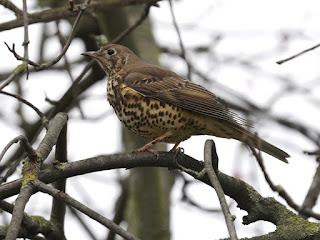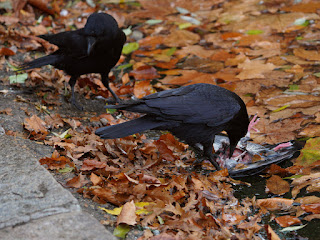Now that we know that there is a pair of Little Owls on Buck Hill, the question is: where is their nest hole? The old squirrels' drey where they have been seen (this one is the male) is no good as a nest because it doesn't have a solid floor for the eggs. I have my eye on a big old oak near the road, from which I have several times heard an owl calling.
Just along the path, the Mistle Thrush is still guarding its rowan tree. Its vigilance wasn't much use yesterday when the tree was invaded by other birds.
There are now quite a lot of Song Thrushes in the park. Some of them must be winter migrants. All the males are singing occasionally, despite the recent colder weather. This is the one near the leaf yard, which is a permanent resident.
The one on Buck Hill is probably a migrant ...
... but there are two pairs permanently in different parts of the Flower Walk.
One of the Coal Tits in the Flower Walk looked out from a stem. I think that both of the pair will be coming to the hand as the weather gets colder. It's important for them because otherwise larger birds will get all the food. The Flower Walk is already infested with Rose-Ringed Parakeets whose unwelcome presence drives out small native birds.
Long-Tailed Tits seem to be unaffected by the invaders. They nest in bushes rather than holes, which makes them less vulnerable.
Jackdaws are hole nesters but probably strong enough to repel parakeets.
Carrion Crows finished off the remains of the pigeon-eating gull's breakfast.
A Grey Wagtail stared from a rail in the Italian Garden ...
... and a Pied Wagtail hunted at the Lido.
The ropes on the boat platform are irresistible to Herring Gulls. Even adults can't stop pulling them.
A Great Crested Grebe preened on the Serpentine. This is an adult in winter plumage. They are now hard to distinguish from the fully grown juveniles, but the faint marks on their neck have no trace of vertical stripes.
The new pair of Egyptian Geese in the Italian Garden used the Mute Swans' nesting island as a quiet place to preen, safe from humans and their dogs.
It takes Egyptians a long time to maintain their big complicated wings.
A Tufted Duck preened under the willow near the bridge.













I wonder why Egyptians want those large broad wings for. They don't really migrate very far, although I confess my knowledge of Egyptians' habits is sadly limited by their scarcity here in the wild.
ReplyDeleteYes, I have often wondered too. The Egyptians in the park are amazingly sedentary. Blondie likes to stay within 50 metres of where she was hatched (the nest was on the ground and I saw her soon after she emerged, conspicuously pale). She went to the Round Pond once and to St James's Park once, didn't like them, and is now back on her home ground.
DeleteWas the nest on an island, or behind railings? It's perilous enough with the foxes, let alone the dogs that are let loose. Jim
DeleteIt was well behind railings in a patch of scrub which fortuitously could be viewed around the corner of the lake. Unusual for an Egyptian nest to be on the ground, but there it was for anyone with a pair of binoculars to see.
DeleteNice selection of thrushes here. I went along to the monthly bird walk in Walpole Park, Ealing yesterday morning. We had several Redwing, a tame singing Song Thrush but not a single Blackbird nor Mistle Thrush; the latter a pair or 2 usually breeding.
ReplyDeleteThere does seem to be a severe shortage of Blackbirds. Numbers have been picking up slightly in the park since the low point around 2012, but now the recovery seems to have reversed. For the record, when Roy Sanderson did a survey of the Blackbirds in Kensington Gardens in the 1960s he found over 200 territories. When he repeated the survey in 2011 there were just 18.
DeleteThat is a massive decline, Ralph.
ReplyDeleteI'm hoping that it may be reversed by reduced leaf blowing. This year the Kensington Gardens staff have been issued with utterly feeble electric blowers rather than the harmfully efficient petrol-powered ones they had previously. The machines have little puff in normal mode, and if put into high mode they run out of charge in 45 minutes. On the lawns, fallen leaves are no longer being picked up, and are shredded into fragments by running the big gang mower over them. This can only help birds that depend on leaf litter. However, in Hyde Park the bad old ways continue.
Delete